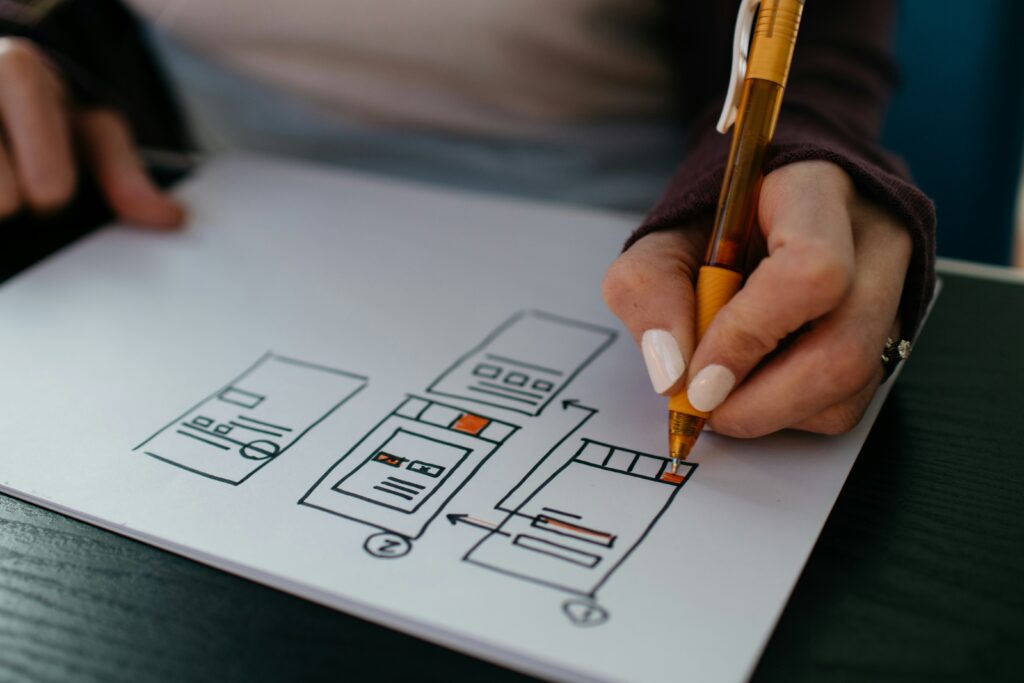As we move into 2024, UX/UI design continues to evolve, driven by technological advancements and changing user expectations. Here are some of the key trends in UX/UI design for the upcoming year:
1. Dark Mode Everywhere
Dark mode has been popular for a few years, but in 2024, it’s becoming a standard feature across websites and apps. It not only reduces eye strain but also conserves battery life on OLED screens.
Designers are creating dark mode versions of their interfaces that look just as good as, if not better than, their light mode counterparts.
2. Neumorphism
Neumorphism, or “soft UI,” blends skeuomorphism and flat design to create interfaces that are minimalistic yet slightly three-dimensional. It uses subtle shadows and highlights to make elements appear as if they are extruded from the background, providing a tactile, almost physical feel.
3. Voice User Interface (VUI) Integration
With the rise of voice assistants like Siri, Alexa, and Google Assistant, integrating VUI into apps and websites is becoming more common.
This trend focuses on creating seamless voice interactions, allowing users to perform tasks hands-free and improving accessibility for those with disabilities.
4. Micro-Interactions
Micro-interactions are subtle animations that provide feedback and enhance the user experience. They make interfaces more intuitive and engaging by offering visual cues for user actions.
In 2024, expect to see more sophisticated and creative use of micro-interactions to guide users and make digital experiences more enjoyable.
5. Augmented Reality (AR) Experiences
AR is becoming a mainstream feature in UX/UI design, especially in e-commerce, real estate, and education.
AR enhances the user experience by overlaying digital information onto the real world, allowing users to visualize products in their environment, access interactive tutorials, or explore virtual spaces.
6. Inclusive Design
Inclusive design ensures that products are accessible to people with diverse abilities and backgrounds.
In 2024, there is a stronger emphasis on designing for accessibility from the ground up, including features like voice navigation, text-to-speech, adjustable font sizes, and high-contrast modes.
7. Minimalism and Maximalism
While minimalism continues to be popular with its clean lines and simplicity, maximalism is making a comeback, especially in certain niches like entertainment and fashion. Maximalist designs are bold, colorful, and feature rich textures and intricate details, offering a more immersive experience.
8. 3D Elements and Illustrations
The use of 3D elements and illustrations is on the rise, creating more dynamic and engaging interfaces. These elements can range from simple icons to complex, interactive models, adding depth and interest to the user experience.
9. Personalization
Personalization is key to providing a user-centric experience. In 2024, AI and machine learning enable deeper personalization, offering content, recommendations, and interfaces tailored to individual user preferences and behaviors.
10. Sustainable and Ethical Design
As awareness of environmental and ethical issues grows, sustainable design practices are becoming more important. This includes using energy-efficient design elements, promoting digital well-being, and ensuring that design processes and technologies are ethically sound.
11. Asymmetrical Layouts
Breaking away from traditional grid structures, asymmetrical layouts create more visually interesting and dynamic pages. These layouts can draw attention to specific elements and guide the user’s eye in a more organic way.
12. Immersive Scrolling and Parallax Effects
Innovative scrolling experiences and parallax effects are being used to create more interactive and engaging pages. These techniques make the user experience more immersive, guiding users through a story or journey as they scroll.
13. Glassmorphism
Building on the popularity of neumorphism, glassmorphism uses frosted glass effects to create a sense of depth and layering. This trend often involves translucent elements with blurred backgrounds, giving interfaces a sleek and modern look.
14. Animated Logos and Branding
Animated logos and branding elements add a dynamic and memorable touch to user interfaces. These animations can range from subtle movements to complex sequences, helping brands stand out and convey their identity more effectively.
15. Advanced Typography
Typography continues to evolve with more creative and experimental uses of type. Variable fonts, which allow for dynamic adjustments in weight and width, are becoming more common, offering designers greater flexibility and control.
In conclusion, 2024’s UX/UI design trends reflect a balance between functionality and creativity, with a strong emphasis on user-centric and inclusive design. Staying abreast of these trends can help designers create more engaging, accessible, and innovative digital experiences.

